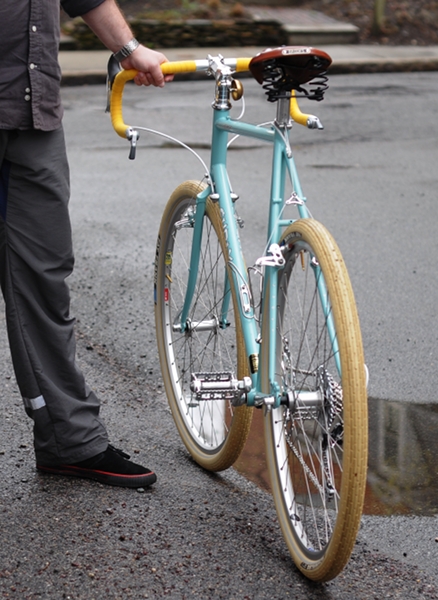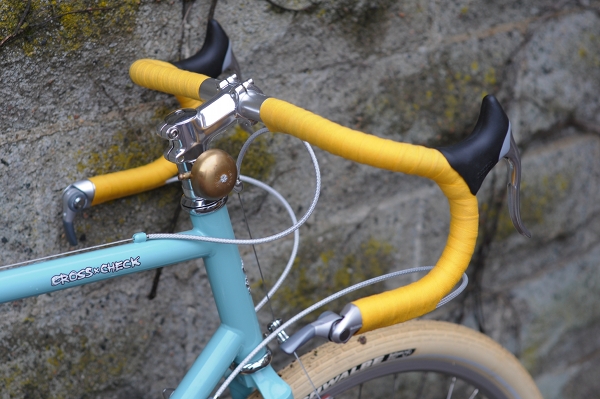We are nearly done building up the Co-Habitant's Surly Cross Check, and here is an update on the progress:
As mentioned previously, we got this frame to build up as a fun off-road bike. We already had the wheelset, Fat Frank tires, handlebars, saddle, pedals, and some other components, making the remaining build fairly easy and financially feasible.
Among the new components we bought were the Velo Orange threadless headset and stem. Though we do not plan to transition to threadless stems, they do make life easier in some respects - such as making it possible to remove the handlebars without redoing the bar tape and lever placement. And as far as threadless stems go, the VO is rather nice looking.
The brass bell is mounted on one of the spacers, which mechanic Jim tapped for us when we were picking up the frame from Harris Cyclery.
The handlebars are only temporarily yellow - Once we shellac them, they will turn caramel to match the saddle. But the bicycle does look kind of cute with them as they are, like an enormous children's toy. The "maiden voyage" was on Easter Sunday, and the colour scheme was certainly appropriate.
We also bought these Velo Orange Grand Cru MK2 cantilever brakes, which I think are just beautiful. Unfortunately, after riding with them for 27 miles the Co-Habitant is not sure whether he is happy with their functionality. In his opinion they do not perform as well as the Tektro cantilever brakes I have on my Rivendell - so he is not sure what to do. It is not a safety issue, since the VO cantis still outperform the old centerpulls he has been using on his Motobecane for the past two years. But he doesn't want to feel as if he is sacrificing performance for looks or "vintageyness," and he thinks that this may be the case here. Has anybody else tried these?
Similarly, he has mixed feelings about the VO metallic braided housing. While beautiful, the brake housing is very stiff and has considerably more friction than the Jagwire we are accustomed to using. I asked about this on bikeforums, and apparently stiffness is a known trait of this particular housing - which is why some avoid it, and others use it only with vintage non-aero brake levers. I wish we had known that before buying and installing the stuff. But now that it's already done, we are trying to determine whether it will perhaps become less stiff over time. Is that a possibility, or just wishful thinking?
The final disappointment is with the fenders, or lack thereof. We had initially ordered the 700Cx60mm Berthoud fenders, which, by all accounts and calculations should have been a perfect fit. The first problem was that the fenders arrived damaged: a crushed box, courtesy of UPS. We filed a damage report and will be returning them, with the hope that the seller will be fully reimbursed. But when examining the fenders, it also seemed quite apparent to us that even had they been intact, they would not fit. In fact, we are genuinely wondering whether the set we received was mislabeled, because they simply don't look like they can clear the 50mm tire. Now we are confused as to whether to ask for an exchange, or simply return them and try the SKS. The Co-Habitant does not like SKS fenders - but then he was not too happy with the quality of the Berthouds either (what we could see of it based on the undamaged parts) - so we are sort of at an impasse on this one.
These glitches aside, we are extremely pleased with the new Surly Cross Check. It took us only one night to put it together, and in that sense a new frame is much easier to work with than an old one. By contrast, we constantly run into unexpected problems when building up vintage frames, which delays those builds by weeks and sometimes months (this is the case with my give-away touring bike, but more on that later). With the Surly, everything came together as expected, with no installation problems.
On its first ride, the Cross Check performed better than the Co-Habitant expected. He anticipated that it would be more comfortable, but slower than his vintage Motobecane roadbike. Instead, it is more comfortable and faster. He does not feel that the frame is too stiff, as some report, which can of course be due to his size and weight. And he definitely does not feel that the bike is in any way sluggish. As his riding partner, I have to agree: He is faster on the Surly than on the Motobecane. Hmm. We are eager to get the brakes and fenders issue resolved, so that he can ride it more - but so far he is impressed.
As mentioned previously, we got this frame to build up as a fun off-road bike. We already had the wheelset, Fat Frank tires, handlebars, saddle, pedals, and some other components, making the remaining build fairly easy and financially feasible.
Among the new components we bought were the Velo Orange threadless headset and stem. Though we do not plan to transition to threadless stems, they do make life easier in some respects - such as making it possible to remove the handlebars without redoing the bar tape and lever placement. And as far as threadless stems go, the VO is rather nice looking.
The brass bell is mounted on one of the spacers, which mechanic Jim tapped for us when we were picking up the frame from Harris Cyclery.
The handlebars are only temporarily yellow - Once we shellac them, they will turn caramel to match the saddle. But the bicycle does look kind of cute with them as they are, like an enormous children's toy. The "maiden voyage" was on Easter Sunday, and the colour scheme was certainly appropriate.
We also bought these Velo Orange Grand Cru MK2 cantilever brakes, which I think are just beautiful. Unfortunately, after riding with them for 27 miles the Co-Habitant is not sure whether he is happy with their functionality. In his opinion they do not perform as well as the Tektro cantilever brakes I have on my Rivendell - so he is not sure what to do. It is not a safety issue, since the VO cantis still outperform the old centerpulls he has been using on his Motobecane for the past two years. But he doesn't want to feel as if he is sacrificing performance for looks or "vintageyness," and he thinks that this may be the case here. Has anybody else tried these?
Similarly, he has mixed feelings about the VO metallic braided housing. While beautiful, the brake housing is very stiff and has considerably more friction than the Jagwire we are accustomed to using. I asked about this on bikeforums, and apparently stiffness is a known trait of this particular housing - which is why some avoid it, and others use it only with vintage non-aero brake levers. I wish we had known that before buying and installing the stuff. But now that it's already done, we are trying to determine whether it will perhaps become less stiff over time. Is that a possibility, or just wishful thinking?
The final disappointment is with the fenders, or lack thereof. We had initially ordered the 700Cx60mm Berthoud fenders, which, by all accounts and calculations should have been a perfect fit. The first problem was that the fenders arrived damaged: a crushed box, courtesy of UPS. We filed a damage report and will be returning them, with the hope that the seller will be fully reimbursed. But when examining the fenders, it also seemed quite apparent to us that even had they been intact, they would not fit. In fact, we are genuinely wondering whether the set we received was mislabeled, because they simply don't look like they can clear the 50mm tire. Now we are confused as to whether to ask for an exchange, or simply return them and try the SKS. The Co-Habitant does not like SKS fenders - but then he was not too happy with the quality of the Berthouds either (what we could see of it based on the undamaged parts) - so we are sort of at an impasse on this one.
These glitches aside, we are extremely pleased with the new Surly Cross Check. It took us only one night to put it together, and in that sense a new frame is much easier to work with than an old one. By contrast, we constantly run into unexpected problems when building up vintage frames, which delays those builds by weeks and sometimes months (this is the case with my give-away touring bike, but more on that later). With the Surly, everything came together as expected, with no installation problems.
On its first ride, the Cross Check performed better than the Co-Habitant expected. He anticipated that it would be more comfortable, but slower than his vintage Motobecane roadbike. Instead, it is more comfortable and faster. He does not feel that the frame is too stiff, as some report, which can of course be due to his size and weight. And he definitely does not feel that the bike is in any way sluggish. As his riding partner, I have to agree: He is faster on the Surly than on the Motobecane. Hmm. We are eager to get the brakes and fenders issue resolved, so that he can ride it more - but so far he is impressed.

















































